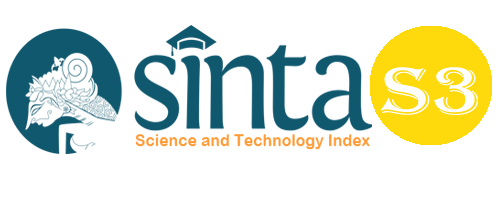Derivational Morphemes in Jack Ma’s Speech: Morphology Study
Abstract
This research aims to identify the types of derivational morphemes by inserting affixes that appears in Jack Ma’s speech and to know the derived words that changes the word categories. The method employed was qualitative descriptive to conduct this research. The data taken were fifty that containing derivational morphemes in Jack Ma’s speech. The results indicated that there are two types of derivational morphemes by inserting affix, namely suffix (74%) and prefix (24%). In addition, there are derived words that change to the new word categories, namely noun forming (44%), adverb forming (20%), adjective forming (20%), and verb forming (16%). The word category changed that occur the most in prefix and suffix is noun forming, such as in-, mis-, -dom, -ion, -ity, -ation, -ness, -ee, -ure, -or, -er, and –ment. Additionally, the least word category changed that occur in prefix and suffix is verb forming such as –en, and –ize.
Keywords
Full Text:
PDFReferences
Ba'dulu, A. M., (2010). Morphosyntax. Badan Penerbit Universitas Negeri Makassar.
Chandra, Y. N. (2016). Morfem Derivasional dalam Bahasa Mandarin. Paradigma, Jurnal Kajian Budaya, 3(1), 78. https://doi.org/10.17510/PARADIGMA.V3I1.35
Crystal, D. (2008). A dictionary of linguistics and phonetics sixth edition. UK: Blackwell Publishing.
Fitria, T. N. (2020). An Analysis of Derivational and Inflectional Morpheme in Selected News From Tempo.Co. Rainbow: Journal of Literature, Linguistics and Cultural Studies, 9(2). https://doi.org/10.15294/rainbow.v9i2.40348
Fromkin, V., et al. (2014). An Introduction to Language. Wadsworth Publishing.
Hasbullah, Hatta, M., and Arifin, Z. (2018). Communication Pattern of Wilayatul Hisbah, Lhokseumawe City in Implementing Amar Makruf Nahi Mungkar. Budapest International Research and Critics Institure Journal, Vol. 1, No. 4, 194-205.
Lieber, R. (2009). Introducing Morphology. New York: Cambridge University Press
Lingga, T. R., Sirait, A., Maulidia, H., R., Kusumah, C., M. (2021). Polysyllabic Stratum Ordering Analysis in Scientific Text: A Morphological Study, https://doi.org/10.33197/ejlutama.vol5.iss2.2020.2655.4585
Maulidina, S., Indriyani, F., & Mardewi, T. (2019). Derivational And Inflectional Morphemes In The Jakarta Post. English Education:Journal of English Teaching and Research, 4(2), 104–122.
Meinawati, E., Putri, T. A., Harmoko, D. D., Setianingrum, H. W., & Alawiyah, S. (2020). Classification of Derivational and Inflectional Morphemes in song lyric of Ariana Grande’s album Thank U, Next. VELES Voices of English Language Education Society, 4(2), 199–212. https://doi.org/10.29408/VELES.V4I2.2529
O' Dwyer, B. T. (2006). Modern English Structures Second Edition. Broadview Press.
O' Grady, et al. (2016). Contemporary Linguistic Analysis. Pearson
Purba, N. et al. (2020). Language Acquisition of Children Age 4-5 Years Old in TK Dhinukum Zholtan Deli Serdang. Linglit Journal: Scientific Journal of Linguistics and Literature. P.19-24
Simatupang, E. C., & Supri, I. Z. (2020). Compound Words That Occur During The Global Pandemic Covid-19: A Morphosemantic Study. English Review: Journal of English Education, 8(2). https://doi.org/10.25134/erjee.v8i2.2824
Yule, G. (2010). The Study of Language Fourth Edition. Cambridge University Press.
Yusuf, M. (2014). Metode Penelitian Kuantitatif, Kualitatif, dan Penelitian Gabungan. Jakarta: Kencana.
DOI: https://doi.org/10.33258/birci.v5i3.5857
Article Metrics
Abstract view : 51 timesPDF - 26 times
Refbacks
- There are currently no refbacks.

This work is licensed under a Creative Commons Attribution-ShareAlike 4.0 International License.

This work is licensed under a Creative Commons Attribution-ShareAlike 4.0 International License.

_.gif)

















_.gif)



